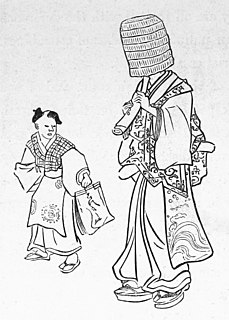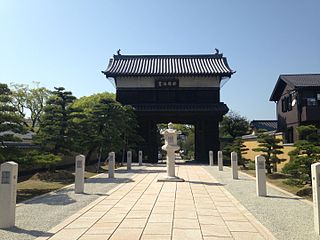
Daitoku-ji is a Buddhist temple, one of fourteen autonomous branches of the Rinzai school of Japanese Zen. It is located in Kita-ku, Kyoto, Japan. The "mountain name" (sangō) by which it is known is Ryūhōzan (龍宝山). The Daitoku-ji temple complex today covers more than 23 hectares.

The Rinzai school is one of three sects of Zen in Japanese Buddhism. The Chinese Linji school of Chan was first transmitted to Japan by Myōan Eisai. Contemporary Japanese Rinzai is derived entirely from the Ōtōkan lineage transmitted through Hakuin Ekaku (1686–1769), who is a major figure in the revival of the Rinzai tradition.

Fuke-shū or Fuke Zen was, according to the legend, a distinct and ephemeral derivative school of Japanese Zen Buddhism which originated as an offshoot of the Rinzai school during the nation's feudal era, lasting from the 13th century until the late 19th century. There are however no historical records to support this. The sect, or sub-sect, traced its philosophical roots to the eccentric Zen master Puhua, as well as similarities and correspondences with the early Linji House and previous Chán traditions—particularly Huineng's "Sudden Enlightenment" —in Tang Dynasty China. The connection to the Zen master Puhua has not been established in historical records, except for a text that was published in 1795 but is most likely a made-up story in order to institutionalize the monks of the Fuke sect.

Kenchō-ji (建長寺) is a Rinzai Zen temple in Kamakura, Kanagawa Prefecture, Japan, which ranks first among Kamakura's so-called Five Great Zen Temples and is the oldest Zen training monastery in Japan. These temples were at the top of the Five Mountain System, a network of Zen temples started by the Hōjō Regents. Still very large, it originally had a full shichidō garan and 49 subtemples.

Ishin Sūden also known as Konchiin Sūden, was a Zen Rinzai monk and advisor to Tokugawa Ieyasu, and later to Tokugawa Hidetada and Iemitsu on religious matters and foreign affairs. He played a significant role in the initial development of the Tokugawa shogunate.

Musō Soseki was a Rinzai Zen Buddhist monk and teacher, and a calligraphist, poet and garden designer. The most famous monk of his time, he is also known as Musō Kokushi (夢窓国師), an honorific conferred on him by Emperor Go-Daigo. His mother was the daughter of Hōjō Masamura (1264-1268), seventh Shikken (regent) of the Kamakura shogunate.
Gentō Sokuchū was a Sōtō Zen priest and the 50th abbot of Eihei-ji, the school's head temple. He was part of a 17th and 18th century movement within the Sōtō school that sought to bring the school's teachings back in line with those of the 13th century founding teacher, Dōgen. To this end, he edited major editions of works by Dōgen and succeeded in disseminating them widely. He is best remembered for compiling the Eihei Rules of Purity, a collection of writings by Dōgen laying out a strict code of conduct for monks. These rules had been largely unheeded in the school in the preceding several centuries, and Gentō used his high position as abbot of Eihei-ji to reintroduce and enforce them. His work on the Eihei Rules of Purity was completed in 1794 while he was serving as the eleventh abbot of Entsū-ji. The following year he became the 50th abbot of Eihei-ji. He was also involved in editing Dōgen's master work, the Shōbōgenzō.
The Unfettered Mind is a three-part treatise on Buddhist philosophy and martial arts written in the 17th century by Takuan Sōhō, a Japanese monk of the Rinzai sect. The title translates roughly to "The Mysterious Records of Immovable Wisdom". The book is a series of three discourses addressed to samurai but applicable to everyone who desires an introduction to Zen philosophy, the book makes little use of Buddhist terminology and instead focuses on describing situations followed by an interpretation. Its contents make an effort to apply Zen Buddhism to martial arts.

Kōgaku-ji (向嶽寺), originally Kōgaku-an, is a Buddhist temple belonging to the Rinzai school of Japanese Zen. located in the city of Kōshū, Yamanashi, Japan. It is the head temple of one of fourteen autonomous branches of the Rinzai school. Its main image is a statue of Shaka Nyōrai. The temple, including its famed Japanese garden is not open to the general public.
Yishan Yining was a Chinese Buddhist monk who traveled to Japan. Before monkhood his family name was Hu.. He was born in 1247 in Linhai, Taizhou, Zhejiang, China. He was a monk of the Linji school during the Yuan Dynasty of China, and subsequently a Rinzai Zen master who rose to prominence in Kamakura Japan. He was one of the chief disseminators of Zen Buddhism among the new militarized nobility of Japan, a calligrapher and a writer. Mastering a variety of literary genres and being a prolific teacher, he is mostly remembered as the pioneer of Japanese Gozan Bungaku literature, that recreated in Japan the literary forms of Song dynasty.
Gudō Toshoku (1577–1661) was a Japanese Rinzai school zen monk from the early Tokugawa period. He was a leading figure in the Ōtōkan lineage of the Myōshin-ji, where he led a reform movement to revitalize the practice of Rinzai. He served three times as abbot of Myōshin-ji. Among his leading disciples was Shidō Bunan (1603–1676), from whose line came the great reformer Hakuin Ekaku (1685–1768). The illustrious Zen preacher Bankei Yōtaku earlier in life wanted to meet Gudō and receive confirmation of enlightenment, but narrowly missed seeing him at his Daisen-ji temple in Mino province because the master was visiting up in Edo (Tokyo). Gudō received the posthumous title Daien Hôkan Kokushi. He left no written words.

Sōfuku-ji (崇福寺) is a Rinzai temple in Hakata-ku, Fukuoka, Japan. Its honorary sangō prefix is Yokodakezan (横岳山). The temple was founded by the monk Tan'e (湛慧) in Dazaifu in 1240, but was moved to its present location in 1600 after it became the Kuroda family temple.

Lanxi Daolong, born in Sichuan Province, China in 1213 A.D., was a famous Chinese Buddhist monk, calligrapher, idealist philosopher, and is the founder of the Kenchō-ji sect, which is a branch of the Rinzai school.
The Ōtōkan lineage (応灯関、應燈關) is a lineage of the Rinzai school of Zen. It was founded by Nanpo Shōmyō, who received the dharma in China in 1265 and returned to Japan in 1267.

Kanzan Egen (関山慧玄/關山慧玄) (1277–1360) was a Japanese Rinzai Zen Buddhist monk, founder of Myōshin-ji Temple and a principal member of the extant Ōtōkan lineage, from which all modern Rinzai Zen derives. Centuries later, Emperor Meiji conferred the posthumous name Muso Daishi (無相大師) to Kanzan.

Gikū or Yikong was an early Heian period Buddhist monk from Tang China. He is Japan's first Buddhist monk who exclusively taught Zen.
Kiiti-ji is a Rinzai Zen temple of the Kenchō-ji branch, located in Matsuzaki-chō, Kamo District, Shizuoka Prefecture, Japan. The temple was founded by Issan Ichinei, a Chinese Buddhist monk who traveled to Japan during the Yuan dynasty of China.

Rinzai-ji (臨済寺), is a Buddhist temple belonging to the Myōshin-ji branch of the Rinzai school of Japanese Zen, Buddhism located in the Aoi ward of the city of Shizuoka, Shizuoka Prefecture, Japan. Its main image is a statue of Amida Nyōrai. It was the bodaiji of the Imagawa clan, a powerful Sengoku period daimyō clan. The temple is noted for its Japanese garden, which is a nationally designated Place of Scenic Beauty; however, the temple is only open to the public for two days each autumn, and it is not possible to view this garden other than during that period.
Shunoku Sōen(春屋宗園) was a Rinzai Zen monk of the Azuchi-Momoyama and early Edo periods and the 111th Head Priest of Daitoku-ji temple. He received the title Zen Master Rōgen Tenshin from Emperor Ōgimachi in 1586 and the highest acclaim of National Teacher Taihō Enkan from Emperor Go-Yōzei (1571-1617) in 1600. Sōen was born in Yamashiro Province and became a monk at an early age. He first trained under Rosetsu Yōha at Kennin-ji before becoming a student of Kōin Sōken at Daitoku-ji. After Sōken's death, Sōen completed his training under Shōrei Sōkin (1505-1584) of Daisen-in and the 107th Head Priest of Daitoku-ji. Sōen became the 111th Head Priest of Daitoku-ji in 1569.

Shūhō Myōchō - Japanese Zen master of the rinzai school, also known as Daitō Kokushi. All the lines of transmission in the rinzai school today are from his teacher. He was the founder and first abbot of the Daitoku-ji (大德寺) in Kyōto, one of Japan's most important temples.













